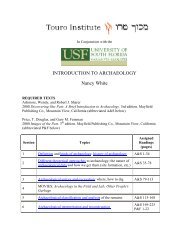In Conjunction with Cultural Anthropology - Touro Institute
In Conjunction with Cultural Anthropology - Touro Institute
In Conjunction with Cultural Anthropology - Touro Institute
You also want an ePaper? Increase the reach of your titles
YUMPU automatically turns print PDFs into web optimized ePapers that Google loves.
3. Briefly describe Kwakiutl exchanges. What brought honor to a Kwakiutl buyer?<br />
4. What are the five categories of economic statuses that make up the U.S. system of economic<br />
classes?<br />
5. What are the three forms of reciprocity, and how do the social relations differ in each?<br />
6. What benefits could Melanesians obtain from participating in the Kula Ring?<br />
7 Explain the differences between a subsistence economy and an economy that produces status<br />
income.<br />
8. What are the four basic means that human societies have used for controlling their economic<br />
systems? Which type of society (i.e., bands, tribes, chiefdoms, and states) is associated <strong>with</strong> each<br />
mechanism?<br />
9. Describe the different ways in which government and private corporations may interact in a<br />
market economy.<br />
10. Define consumer market.<br />
Reading Assignment: Chapter 13: Environment, Adaption, and Subsistence<br />
<strong>In</strong> this assignment you will become familiar <strong>with</strong> the basic natural environments in which human<br />
societies are found and how people adapt themselves to these environments. You will learn how<br />
the concept of adaptation is applied to biology and to culture.<br />
Finally, you will learn the basic subsistence adaptations that anthropologists have found in<br />
various human societies.<br />
Assignment Overview<br />
MCQ :: Matching :: True/False :: Short Essay<br />
MCQ - Chapter Chapter 13: Environment, Adaption, and Subsistence<br />
1. Which is NOT a reason for the relationship between culture areas and natural environments?<br />
a. Environmental boundaries are sometimes barriers to the movement of cultural traits.<br />
b. Adaptations to similar environments are likely to yield similar cultures.<br />
c. Diffusion occurs readily between cultures <strong>with</strong> similar environmental adaptations.<br />
d. Environments determine the characteristics of culture.<br />
2. Which is the type of natural area most densely inhabited by human beings?
















